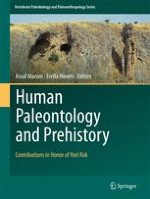2017 | OriginalPaper | Chapter
14. The Acheulo-Yabrudian – Early Middle Paleolithic Sequence of Misliya Cave, Mount Carmel, Israel
Authors : Mina Weinstein-Evron, Yossi Zaidner
Published in: Human Paleontology and Prehistory
Publisher: Springer International Publishing
Activate our intelligent search to find suitable subject content or patents.
Select sections of text to find matching patents with Artificial Intelligence. powered by
Select sections of text to find additional relevant content using AI-assisted search. powered by
